The Trump Administration changed the regulations covering travel to Cuba. Travel is still legal though considerably more restrictive.
Most dramatically, no U.S. citizen may engage in commercial transactions with Cuban military entities. Since all hotels and restaurants are government-owned, the only stays legally allowed are in private homes available for rent.
Known as casa particular, these homes, like Air B&B, can be spartan or comfortable but they are far less available than rooms in hotels.
With this change, the U.S. seeks to put a strangle-hold on the Cuban economy. The situation is similar to what it was during the height of the Cold War, which was when I first visited.
If you find a way to visit Havana and I hope you do, here is my article about why you should want to go and tips to help you while you are there.
________________________________________________________________________
Over almost twenty years, I visited Havana three times, accompanying my wife along with a delegation of her colleagues from the Sundance Institute. Since the 1980s, Robert Redford, founder of the Sundance Institute and Sundance Film Festival, has reached across the ninety miles from the continental U.S. to the island nation of Cuba, extending a hand of friendship, one artist to other artists.
Much has changed since that first visit in 1999. In that year, Cuba was still suffering a kind of emotional withdrawal, a result of the Soviet Union's collapse which denied Cuba the economic and cultural support it had enjoyed since the early 1960s.
Sixteen years later in 2015, there were dramatic changes. Colonial buildings were being renovated into luxury hotels and retail spaces. Cruise ships docked in the harbor and U.S. airlines announced nonstop service from many American cities. Encouraging those efforts, the Obama administration signaled a desire to move away from the isolationist policies that had shunted Cuba's growth.
On the street, when people asked me where I was from and I responded that I was from the U.S., they responded with smiles and shows of great friendship. One man even lifted his t-shirt to show me a tattoo of the Statue of Liberty on his chest. He said proudly, "I love America."
In 2018, the situation is still a great improvement from 1999, but, under a different administration and under pressure from politicians like Florida's Marco Rubio, restrictions on travel by U.S. citizens has slowed tourism and dampened the economy.
When I was asked on this trip where I was from, in response to my saying I was from the U.S., there were no exclamations of joy, only the pitchman's line about wanting to offer me a good deal on a ride in a period American car or recommendations about where I could buy cigars.
12 Reasons to Travel to Havana and 10 Tips When You Get There
The flight from Miami to Havana took less than an hour. After we checked in to the elegant Hotel Nacional, a classic hotel that opened in 1930.
We wasted no time and left the hotel so we could start experiencing Havana. We walked to the Malecón, the iconic seawall that protects the city from the ocean. Two fishermen talked as they held fishing lines in the water.

A group of middle school students in uniforms crossed the street to watch the surf hit the concrete and stone wall and spray into the air.
Most dramatically, no U.S. citizen may engage in commercial transactions with Cuban military entities. Since all hotels and restaurants are government-owned, the only stays legally allowed are in private homes available for rent.
Known as casa particular, these homes, like Air B&B, can be spartan or comfortable but they are far less available than rooms in hotels.
With this change, the U.S. seeks to put a strangle-hold on the Cuban economy. The situation is similar to what it was during the height of the Cold War, which was when I first visited.
If you find a way to visit Havana and I hope you do, here is my article about why you should want to go and tips to help you while you are there.
________________________________________________________________________
Over almost twenty years, I visited Havana three times, accompanying my wife along with a delegation of her colleagues from the Sundance Institute. Since the 1980s, Robert Redford, founder of the Sundance Institute and Sundance Film Festival, has reached across the ninety miles from the continental U.S. to the island nation of Cuba, extending a hand of friendship, one artist to other artists.
Much has changed since that first visit in 1999. In that year, Cuba was still suffering a kind of emotional withdrawal, a result of the Soviet Union's collapse which denied Cuba the economic and cultural support it had enjoyed since the early 1960s.
Sixteen years later in 2015, there were dramatic changes. Colonial buildings were being renovated into luxury hotels and retail spaces. Cruise ships docked in the harbor and U.S. airlines announced nonstop service from many American cities. Encouraging those efforts, the Obama administration signaled a desire to move away from the isolationist policies that had shunted Cuba's growth.
On the street, when people asked me where I was from and I responded that I was from the U.S., they responded with smiles and shows of great friendship. One man even lifted his t-shirt to show me a tattoo of the Statue of Liberty on his chest. He said proudly, "I love America."
In 2018, the situation is still a great improvement from 1999, but, under a different administration and under pressure from politicians like Florida's Marco Rubio, restrictions on travel by U.S. citizens has slowed tourism and dampened the economy.
When I was asked on this trip where I was from, in response to my saying I was from the U.S., there were no exclamations of joy, only the pitchman's line about wanting to offer me a good deal on a ride in a period American car or recommendations about where I could buy cigars.
12 Reasons to Travel to Havana and 10 Tips When You Get There
The flight from Miami to Havana took less than an hour. After we checked in to the elegant Hotel Nacional, a classic hotel that opened in 1930.
We wasted no time and left the hotel so we could start experiencing Havana. We walked to the Malecón, the iconic seawall that protects the city from the ocean. Two fishermen talked as they held fishing lines in the water.

A group of middle school students in uniforms crossed the street to watch the surf hit the concrete and stone wall and spray into the air.
The day was clear and warm, perfect to take a long walk. In the middle of a residential block with towering rows of apartments, we went inside Bar San Juan on the corner of Vapor and Calle 0. Definitely off-the-beaten-path, Bar San Juan is a friendly, neighborhood hang-out. We took a seat at the curved wooden bar. The door and windows were open. The flags hanging from the ceiling fluttered in the breeze. My wife ordered a mojito and I had a long pour of Havana Gold rum. The mojito had a bright freshness, just the right drink on a warm day. The rum was mellow, golden and delicious.
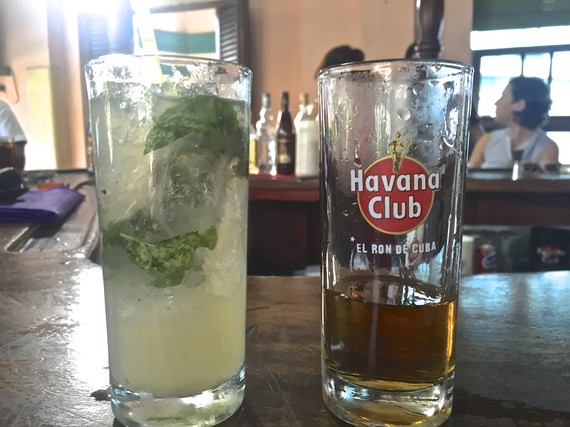
We had a friendly conversation with the barmen. The flags hanging from the ceiling were from just about every country on the planet, except for the United States. The bar was run by Cubans who had fought in the Angolan conflict. At that time they were Fidel Castro's point-of-the-spear, pursuing Communism's interests through out the Third World.
Now that is all in the past, remembered largely in the flags hanging from the ceiling and the photographs of armed soldiers on the walls.

We had a friendly conversation with the barmen. The flags hanging from the ceiling were from just about every country on the planet, except for the United States. The bar was run by Cubans who had fought in the Angolan conflict. At that time they were Fidel Castro's point-of-the-spear, pursuing Communism's interests through out the Third World.
Now that is all in the past, remembered largely in the flags hanging from the ceiling and the photographs of armed soldiers on the walls.
How to plan your trip
If you book your travel on a group tour, you can choose one that focuses on your interests. You can tour historic Havana, churches, cigar factories, artists’ studios, art galleries, museums, nightclubs and restaurants, UNESCO heritage sites or beaches outside of Havana to lounge or go scuba diving.
If you book your travel on a group tour, you can choose one that focuses on your interests. You can tour historic Havana, churches, cigar factories, artists’ studios, art galleries, museums, nightclubs and restaurants, UNESCO heritage sites or beaches outside of Havana to lounge or go scuba diving.
On a first time visit you will want to spend five days or a week. The first two days will be spent exploring the city on foot or with a driver so you learn the layout of the city. Havana is large, but the locations of interest for visitors are mostly concentrated in a few areas. During your stay you will want to visit museums, art galleries, churches, historical sites and relax at the outdoor cafes to enjoy a pleasant meal.
And, of course, you will enjoy music while you are in Havana. As you walk in the street, music will pour out of radios in people’s homes. There are nightclubs, jazz clubs and nostalgic musical reviews like Cabaret Parisien and Cabaret Tropicana. Small bands play in cafés and bars where you can enjoy the music called “son” that was popularized by the movie, the Buena Vista Social Club.
You will pass open air cafés like Sofia Restaurant on the corner of Avenida 23 at Calle O intending to have a quick coffee, but a band with a singer and five musicians will be playing. You finish your coffee but the music is so infectiously joyful, you end up staying the rest of the afternoon. When the band takes a break, you’ll buy one of their cassettes in an effort to prolong the experience by playing the CD when you get home. But nothing is as good as being in the café, in Havana, on a day when the weather is just right and the music is so full of life. Which means, before you leave the café you will be planning your next visit to Cuba.
One day I walked almost ten miles across the city where I saw Havana’s rich history displayed in its architecture with a complex mix of Spanish colonial, Art Deco, 1950s modern and Soviet era concrete-block buildings.
You can’t go to Havana without encountering vintage 1950s and 1960s American cars. When you are riding in the back seat of a beautifully restored convertible 1958 Ford Fairlane, you will look up at the passing palm trees and enjoy the warm breeze on your face, imagining that you have slipped back in time.
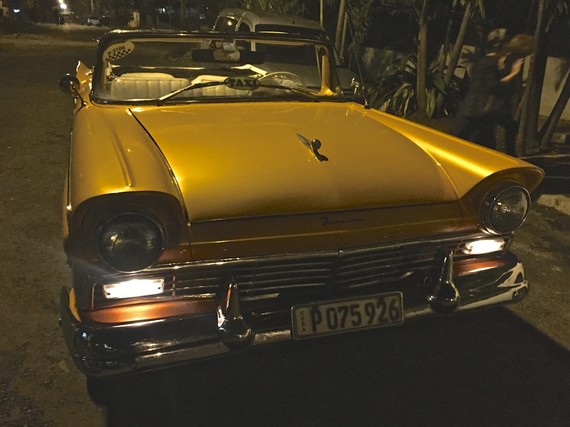

In the old city (La Habana Vieja), you will walk the narrow streets to buy souvenirs from narrow stalls tucked into old buildings, look at the work of local artists and search for Ernest Hemingway’s haunts so you can belly up to the bar and order mojitos and daiquiris like Papa did. You’ll be tempted to buy a hand-rolled Cuban cigar from one of the old women in white who are everywhere in the old city. But you have heard that the women who always have fat cigars in their clinched teeth do not sell quality cigars so you seek out the Partagas cigar factory (Calle Industria No. 520, Centro Habana) and watch cigars being hand-rolled.
Central Havana
To experience the city as locals do, walk into the central city. There you will see the effects of the embargo.
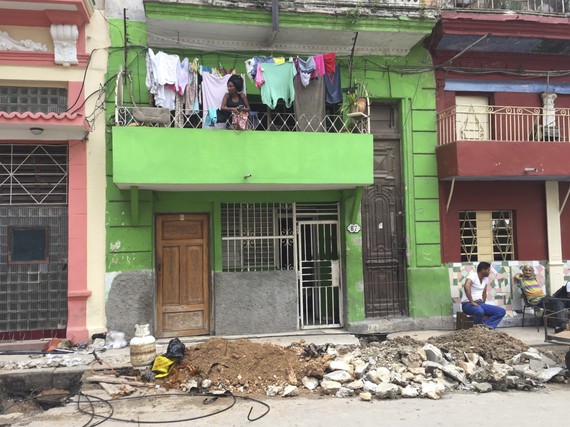
Here the streets are potholed and the buildings continue to suffer the ravages of nature and the lack of building materials to make much-needed repairs.
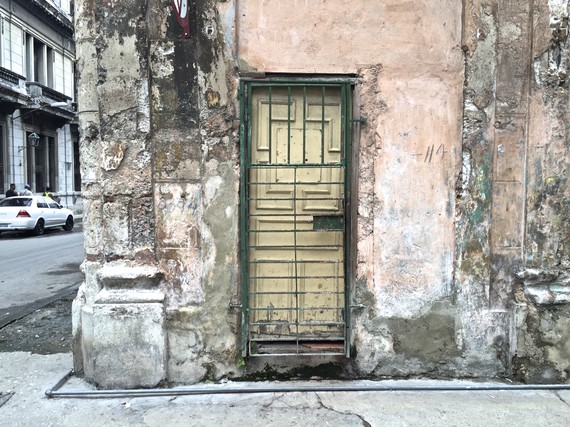
To experience the city as locals do, walk into the central city. There you will see the effects of the embargo.

Here the streets are potholed and the buildings continue to suffer the ravages of nature and the lack of building materials to make much-needed repairs.

The big questions about Cuba are, when will the embargo end and how will that change the country? Commercial ties will certainly lead to commercial development.
East Germany, China and Vietnam were all transformed when they transitioned from Communist to Capitalist economies. But those countries were variations on a theme. Prosperous China and Vietnam are still controlled societies with human rights issues, where as East Germany has been absorbed into Democratic West German.
No doubt Cuba will have its own version.
Change could be gradual or rapid depending on how the Cuban government manages the transition. Once the embargo is lifted by Congress, U.S. banks will set up relationships inside Cuba. That will mean U.S. credit cards will be accepted. American corporations as varied as McDonalds, KFC, Starbucks, the Gap, Disney, Bloomingdale’s, Macy’s, Hilton, Ritz-Carleton and Starwood will look to find opportunities in Cuba.
Change could be gradual or rapid depending on how the Cuban government manages the transition. Once the embargo is lifted by Congress, U.S. banks will set up relationships inside Cuba. That will mean U.S. credit cards will be accepted. American corporations as varied as McDonalds, KFC, Starbucks, the Gap, Disney, Bloomingdale’s, Macy’s, Hilton, Ritz-Carleton and Starwood will look to find opportunities in Cuba.
What Havana will look like in five years is anyone’s guess. If you go now, you will experience Havana as the change is just beginning. Now is a good time to travel to Cuba.
12 Reasons Why You Should Visit Havana
1. The Tourist Area of Old Havana (La Habana Vieja)
Certainly you will want to explore many parts of the city, but definitely walk on busy, crowded Calle Obispo from Calle Mercaderes, near Havana Harbor, west to Avenida Bélgica.
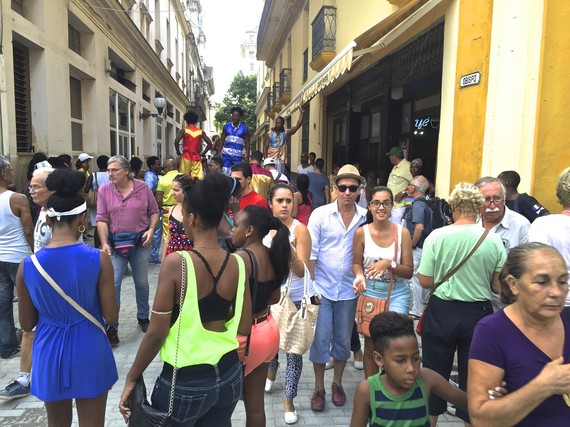
The narrow street has closet sized curio shops selling refrigerator magnets celebrating Havana’s cigars, cars and women, small mass-produced art works, stuffed dolls, marionettes, t-shirts with a photograph of Ernesto "Che" Guevara and much much more.


The narrow street has closet sized curio shops selling refrigerator magnets celebrating Havana’s cigars, cars and women, small mass-produced art works, stuffed dolls, marionettes, t-shirts with a photograph of Ernesto "Che" Guevara and much much more.

Go with the flow and walk with the mass of people eating elote (corn on the cob on a stick), sticky pastries and small Cuban sandwiches. If you are lucky there will be music. Serenading bands set up on street corners, hoping for a donation. One day when I walked among the crowds, a colorful group of performers danced in the middle of the street on five-foot tall stilts.
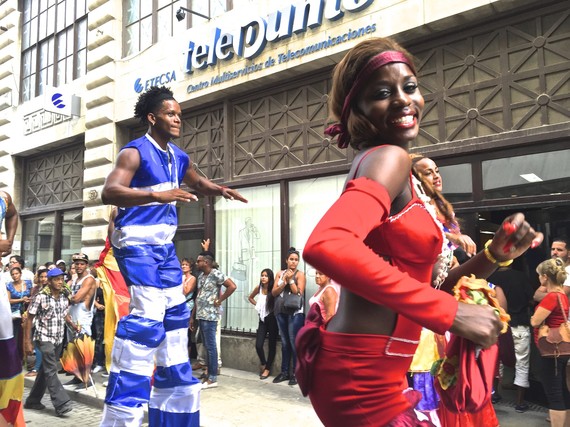
Dressed in Mardi Gras-styled multi-colored outfits, they would have been at home in New Orleans or Rio de Janeiro. Some of the men and women played instruments, the others smiled and shimmied, reaching out to children on their parents’ shoulders or to couples standing, arms around each other, enjoying the impromptu celebration of all things Cuban.
2. Historical Havana
Travel anywhere in the world and you will see plaques describing the historical importance of a grassy field, a building or a promontory. Many of those sites mark the conclusion of a battle and rail against those who were vanquished by the nation’s brave defenders. In Havana those markers can be uncomfortable for Americans. While there are many markers referencing the Spanish occupation of Cuba, there are as many noting when the United States initiated an attack or attempted an invasion.
Americans typically describe themselves as the good guys, so it takes a bit of effort to put your mind around the fact that in Cuba we have been perceived as the bad guys for a very long time.
The mix of current enthusiasm and historical enmity for America is part of what makes Havana what it is. Stop by the Nautica Bar on the back patio of the Hotel Nacional.

Take a leisurely stroll on the walkway through the lawn facing the Malecón and the beautiful water beyond. The historical markers detail the time when America and Cuba faced one another canons blazing and soldiers dying under a hot sun. On a blue sky day, when the water sparkles and delicate white clouds float overhead, it is difficult to imagine such violent events happening, but they did happen and it is important to remember that history as the two countries look to reconnect in a more constructive way.

Take a leisurely stroll on the walkway through the lawn facing the Malecón and the beautiful water beyond. The historical markers detail the time when America and Cuba faced one another canons blazing and soldiers dying under a hot sun. On a blue sky day, when the water sparkles and delicate white clouds float overhead, it is difficult to imagine such violent events happening, but they did happen and it is important to remember that history as the two countries look to reconnect in a more constructive way.
3. 1950s and 1960s American Cars
Vintage American cars are an iconic feature of Havana. You will enjoy the sight of so many antique Buicks, Pontiacs, Chrysler Plymouths, Ford Fairlanes, Chevrolets, Dodges and Studebakers. The most perfectly restored cars popular with foreign visitors wait for fares close to the hotels and in major plazas like José Martí Revolution Square.

I
f you are a romantic, you will want to ride around Havana in one of those cars that evoke sex and glamour. But they are not cheap.

I
f you are a romantic, you will want to ride around Havana in one of those cars that evoke sex and glamour. But they are not cheap.
The cars can be rented for an hour or a portion of the day. That can be arranged in advance by your travel agent or by the hotel concierge. Cars can also be booked online from Nostalgic Car Cuba (www.nostalgicarcuba.com).
You can also be spontaneous. If you see a car you like, ask if it is available and hop in for a memorable ride. Before you get in the car, confirm the price and the amount of time you have booked.
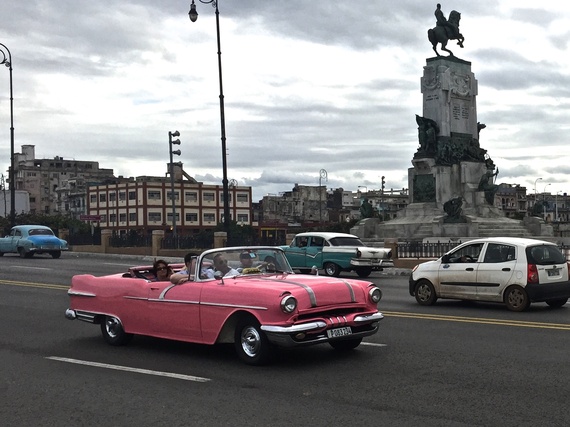

Not all of Havana’s vintage cars are precious artifacts. Walk on streets where locals live, like Neptuno going west from where it crosses San Miguel and the vintage cars are not pretty and shiny.
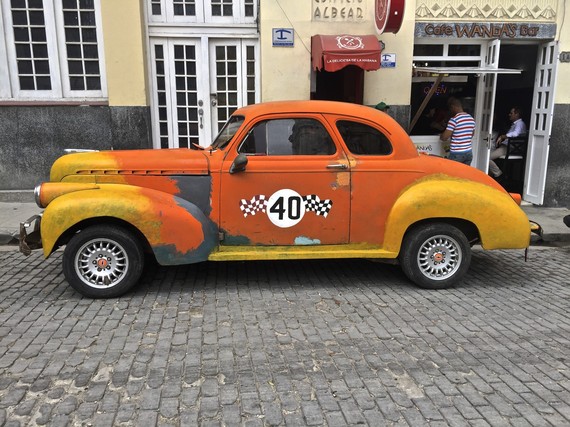
Held together by bailing wire, duct tape and Cuban ingenuity, those cars with dulled paint and thread-bare seats are the workhorses of the city, transporting people and goods for a few pesos a trip.

Held together by bailing wire, duct tape and Cuban ingenuity, those cars with dulled paint and thread-bare seats are the workhorses of the city, transporting people and goods for a few pesos a trip.
4. The Museum of the Revolution
A must stop on a trip to Havana. Formerly the Presidential Palace, the Museum has exhibits detailing Spain’s colonization of the island, the period of Fulgencio Batista’s dictatorship, the armed struggle that over threw him and American attempts at intervention like the Bay of Pigs.
Some of the exhibits attest to a decadent opulence, like the sold gold telephone given to Batista and featured in Godfather, Part II.
In the open area in back, there are relics from those struggles, including a Russian designed SA-2, surface-to-air missile like the one that brought down a U-2 spy plane during the Cuban Missile Crisis as well as warplanes and a tank used to defend the island.
Museo de la Revolución, Calle Refugio No. 1 between Monserrate and Zulueta, La Habana Vieja
5. The Palace of Fine Arts
Across the street from the Museum of the Revolution, the Palace of Fine Arts has a wonderful collection of art covering five centuries. Allow enough time to spend several hours exploring the galleries and enjoy a cup of strong Cuban coffee and a snack in the open-air café next to the ground floor, outdoor sculpture garden. The art in the museum was either created in Cuba or is the work of Cuban artists.
Begin your tour on the top floor with pre-Colonial paintings by Cubans and Europeans who saw in the lush landscape an untamed beauty. As you walk around each floor, you will progress in time, exploring the vision of Cuba as aesthetic styles changed. Politics will become a topic as well as gender politics. The collection includes paintings and sculptures.
Occasionally there are exhibits by non-Cubans like the English photographer, Peter Turnley whose show we saw in 2015.
Begin your tour on the top floor with pre-Colonial paintings by Cubans and Europeans who saw in the lush landscape an untamed beauty. As you walk around each floor, you will progress in time, exploring the vision of Cuba as aesthetic styles changed. Politics will become a topic as well as gender politics. The collection includes paintings and sculptures.
Occasionally there are exhibits by non-Cubans like the English photographer, Peter Turnley whose show we saw in 2015.
There are so many excellent works on display, you will have your favorites and I had mine. I especially enjoyed the mid-century work of Mariano Rodríguez (1912-1990) whose sensuous paintings utilized many styles, the brilliant and satirical cartoonist Rafael Blanco (1885-1955) who attacked the pretensions of the upper classes and politicians.
Museo Nacional de Bellas Artes de La Habana, Trocadero Street between Zulueta and Monserrate, La Habana Vieja, +53 7861-3858 or +53 861-5777, http://www.bellasartes.cult.cu
6. F.A.C. or Fábrica de Arte Cubano
On everyone’s short list of places to visit in Havana, Fábrica, as it is known locally, is a sprawling complex with an art gallery, disco, screening room, café, restaurant, bar and lecture space. A tall smoke stack towers over the block-long, three story building.
The lively complex would be at home in Brooklyn, Paris or London. An artists’ collective originally subsidized by the government, Fábrica is an affordably priced gathering spot for young people, artists and visitors.
The lively complex would be at home in Brooklyn, Paris or London. An artists’ collective originally subsidized by the government, Fábrica is an affordably priced gathering spot for young people, artists and visitors.
Open from 8:00 PM-3:00 AM Thursday-Sunday, you will want to come early so you can view the art in the galleries before the crowds flood into the building and the throbbing music overwhelms conversation.
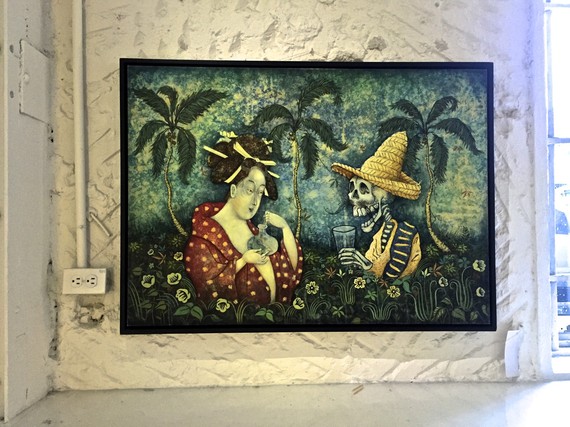
By design much of the art has political undertones. On our visit in 2016, some of the paintings, sculptures and photographs are overtly political like Fernando Rodríguez’s 2012 “Suprematismo (Rojo sobre Negro)” with two hundred toy-sized red bulls mounting black cows next to a video loop of a speech by Fidel Castro.
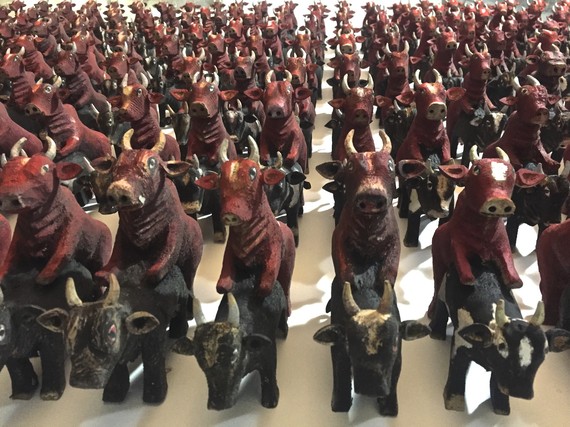
A word of advice. You will tell your friends to hold on to the tickets they were given when they entered. Instead of paying for food and drinks in the café and bar, each person’s ticket is marked. When you leave, your bill is totaled. You will patiently explain to your friends that if they lose their tickets, they cannot leave without paying a substantial fee.
Fábrica de Arte Cubano (F.A.C.), Calle 11 #61, at 26th, Vedado, +53 7838-2260
7. Street Art
You will want to check out the street art that is everywhere in Havana, but there is no guide book to show you where to see inventive, colorful graffiti, murals and caricatures. Some are crudely drawn on stucco walls.

Many are the work of talented artists who make the city their gallery. Your feet will be your guide as you wander the main boulevards and off-the-beaten-path streets.

Some of the best art I saw was on the wooden walls surrounding construction sites, like the murals outside the under renovation Museo Nacional de la Música (on Aguiar and Avenida Belgica).

Many are the work of talented artists who make the city their gallery. Your feet will be your guide as you wander the main boulevards and off-the-beaten-path streets.

Some of the best art I saw was on the wooden walls surrounding construction sites, like the murals outside the under renovation Museo Nacional de la Música (on Aguiar and Avenida Belgica).
Much of what I saw might be gone before you visit Havana. But not the art at Salvador Gonzáles Escalona’s Callejón de Hamel, a collection of sculptures and murals in a pedestrian walkway.
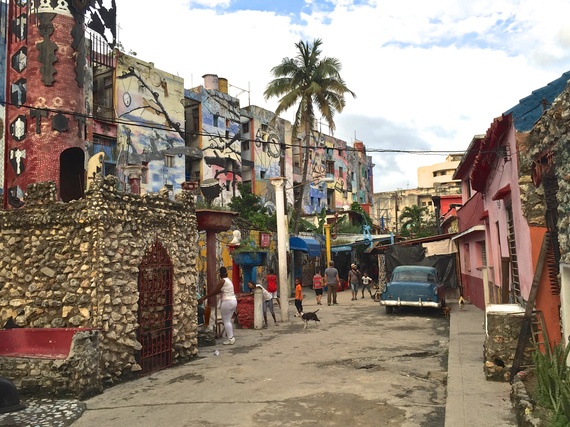
The images are Afro-Cuban, with a heavy dose of Santería images. Everyday objects—bathtubs, tires, pots, pans, stones, bathroom sinks and wrought iron fences—are incorporated into wildly painted collages, sculptures and the walls of buildings.
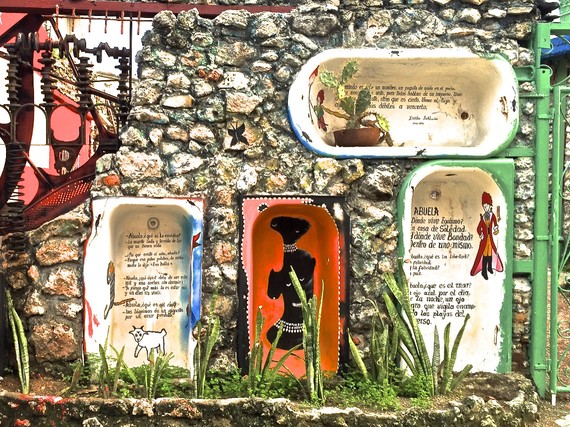
Children have art classes under the shaded patio and musicians gather to play and ask for donations. A paladar serves food and drinks. Artists sell their paintings in small galleries, some reached by descending twisting staircases into basement showrooms.
Callejón de Hamel, San Lazaro # 955 between Aramburu and Hospital
8. Paladares
You have probably heard about paladares, the small dining establishments set up by families in their homes. When they first appeared, the Cuban government variously tolerated and then shuttered them. Now they are heavily promoted as a distinctive feature of Havana culture.
In 1999 we ate at La Guarida, a small apartment on the third floor of what had been an elegant mansion with a magnificent, curved staircase. The restaurant was in the front rooms of the apartment where the sofas and coffee table had been replaced by small dining tables and rickety chairs. The food was good but not special. Featured in Tomás Gutiérrez Alea’s Strawberry and Chocolate (Fresa y chocolate), La Guarida became famous as “the” paladar to visit in Havana. That is still true today. But what is different is La Guarida itself.
The restaurant and bar have taken over the entire third floor. The intimate dining rooms are decorated with antiques and beautiful paintings. The food is excellent, as good as any meal you would enjoy in a 5-Star European hotel, with prices to match.
Today, there are many paladares and many types of paladares. Some, like La Guarida serve European style cuisines in settings that look very much like upscale restaurants. Others like Ivan Chef Justo still feel like you are eating in a family’s home with bookcase lined walls, decorated with black and white photographs.
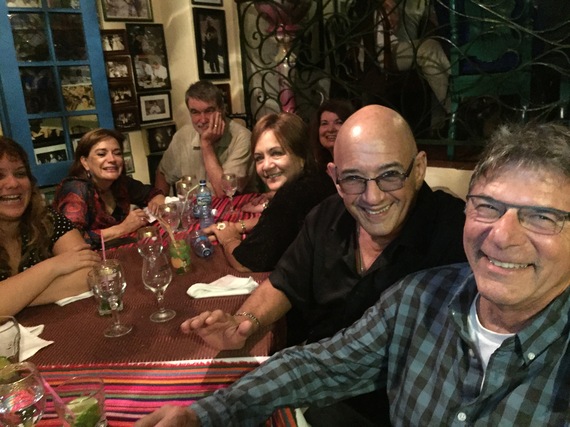
Ivan Chef Justo is cluttered in a cozy, fun way and the food is delicious. You will especially enjoy the roast pork and the sauce served with the lobster. Both Ivan and Justo had been Fidel Castro’s chefs at moments in their careers.
They have opened a cafe on the bottom floor which is open for lunch and dinner.

Ivan Chef Justo is cluttered in a cozy, fun way and the food is delicious. You will especially enjoy the roast pork and the sauce served with the lobster. Both Ivan and Justo had been Fidel Castro’s chefs at moments in their careers.
They have opened a cafe on the bottom floor which is open for lunch and dinner.
In the space next to Fábrica, El Cocinero on the second floor has the open, modern feeling of an upscale restaurant you enjoy visiting in New York, Miami or Los Angeles. Brightly colored paintings hang on the walls inside and outside a sprawling deck is shaded by tall tropical plants. Serving a European menu, the food is well-prepared and platted in a way that makes what you are about to eat as fetching as the art on the walls.
You may be seated in the second floor dining room or on the rooftop terrace with a bar. In either case, you will certainly want to visit the third floor for a drink and to make the final climb up the spiral metal staircase to the deck with a view of the city.
La Guarida, Concordia No. 418, between Gervasio and Escobar, Centro Habana,
+53 7866 -9047, +53 7866-2354, +53 5414-7852, www.laguarida.com
Ivan Chef Justo, Aguacate 9, Esquina Chacon, La Habana Vieja, +53 7863 – 9697, +53 5343-8540
El Cocinero, Calle 26 between Calle 11 and Calle 13, Vedado, +53 7832-2355
9. Restaurants and Roof-Top Bars
The restaurants and cafés catering to tourists serve food that varies in quality. Some of the better restaurants have a Cuban-Italian menu like El Litoral (on the Malecón just west of the American Embassy and Hotel Nacional), a pleasantly modern European style café with a good bar. El Litoral has an antipasto table with a selection of salads, pizza and seafood and a full menu with upscale presentations of familiar European dishes and some typical Cuban dishes. The French fries are especially good.
Jacqueline Fumero Café is a block east of the Museum of the Revolution on a narrow street. The restaurant has a large Italian menu with service outside on a patio. On a sunny, cool day, you will definitely want to eat outside.
If you want to try a restaurant where locals go, you will want to visit Kasalta Sports Bar-Restaurant. Hopefully you speak Spanish because none of the waiters speak English. If four of you are eating together, you will ask for one order of the Pollo Kasalta. What will arrive at the table will be two large plates. One plate is topped with four large chicken legs and thigh, the other with a serving of soy sauce flavored fried rice with savory bits of chicken, ham and shrimp. That will cost you only $12 CUC and you will be very satisfied. Even if you are no longer hungry, you not be able to resist an order of flan served with paper-thin slices of fresh pineapple. After a round of espressos, you will be ready to continue with your exploration of Havana.
Like many cities, Havana is learning to exploit its rooftops. Go on a roof-top bar-crawl and start at the Saratoga Hotel, move on to the Hotel Ambos Mundos (corner of Calles Obispo and Mercaderes) and go upstairs above El Cocinero to the roof-top bar and enjoy a drink (the piña coladas are creamy-delicious!) before going next door for dancing, art and films at Fábrica.
A must-stop is El Del Frente ("the one in front"), sister roof-top bar to the well-established bar O'Reilly303. The drinks and food are good. The charming roof-top bar has a great collection of neon and a view of the night-sky. With a large group, you can gather around a long table, share plates of well-made food and sample the excellent selection of cocktails.
El Del Frente, 303 O'Reilly, Habana Vieja, +53 78630206.
El Litoral, Malecón 161 E, between K and L, Vedado, +53 7830-2201
Jacqueline Fumero Cafe & Boutique, Compostela No. 1 Esquina Cuarteles, La Habana Vieja, +53 7862-6562, www.jacquelinefumero.com
Kasalta Sports Bar-Restaurant, Calle 5th at 2nd Avenue, +53 7267 1717
Bar Piscina Mirador, Saratoga Hotel, Paseo del Prado #603 Esquina Dragones, La Habana Vieja, +53 7868-1000, www.hotel-saratoga.com
Hotel Ambos Mundos, Calles Obispo 153 at Mercaderes, La Habana Vieja, +53 7860-95-2931, http://www.hotelambosmundos-cuba.com
Rooftop terrace, El Cocinero, Calle 26 between Calle 11 and Calle 13, Vedado, +53 7832-2355
10. Dogs and Cats
Walk around the city and you will meet the other citizens of Havana. Dogs and cats are everywhere and they all look well-fed. Sleeping peacefully on the side walk in front of an art gallery or sitting at the entrance to a small shop, the dogs came in all colors and sizes.
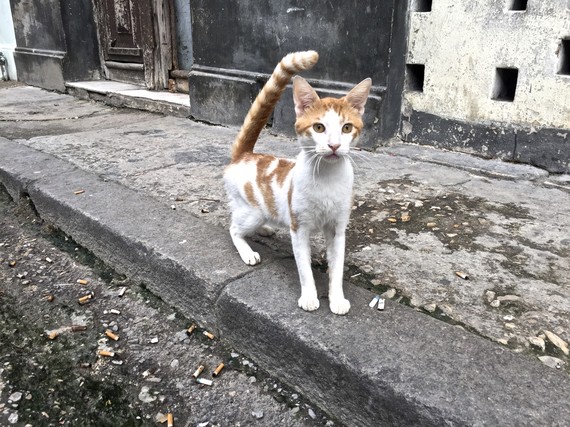
Cats with thick, clean coats watched people walking to restaurants and in and out of curio shops. Their unhurried manner suggesting they had owners who love them.
11. The Malecón
The Malecón is at the center of Havana life even if it is on the northern edge of the city. The broad boulevard curves along the contours of the sea wall. When storms sweep across the island, the waves crash over the broad wall in thirty-foot tall plumes.
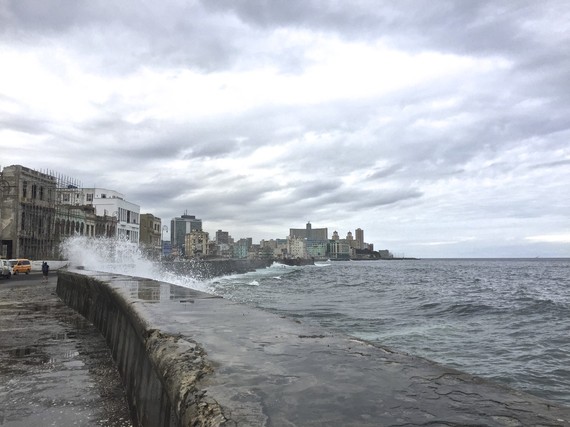
During the day, fishermen stand on the wall, casting their lines into the surf, hoping to bring back the evening’s meal. At night hundreds of young Cubans gather along the seawall to play music, talk, flirt, gossip and go online at the WiFi hotspots called telepuntos.

During the day, fishermen stand on the wall, casting their lines into the surf, hoping to bring back the evening’s meal. At night hundreds of young Cubans gather along the seawall to play music, talk, flirt, gossip and go online at the WiFi hotspots called telepuntos.
12. The United States Embassy
Located across the street from the Malecón, you cannot enter the Embassy without special permission. In the Plaza de la Dignidad, across the street there is a mass of flag poles without flags. In 2006, when the U.S. installed an electronic display that broadcast news the Cuban government had blocked, Fidel Castro responded with a phalanx of flags on tall poles to block the view.
Both the electronic news display and the flags are gone, but the flag poles are very much in evidence as is the Embassy. Inaugurated by Secretary John Kerry in August, 2015, the Embassy is a physical sign that normalization between the two countries has begun in earnest.
10 Tips Once You Are in Havana
1. Tourist Cards
Travel to Cuba is still subject to restrictions but the requirement to state the purpose of the trip has been broadened greatly to include family visits, people-to-people travel and the very general “support of the Cuban people.”
You do not need a visa to enter Cuba, but you do need to buy a Cuban tourist card from a travel agent. Keep the card with your passport. You cannot leave the country without showing the tourist card. When you go through Immigration at the airport on your way home, you will be asked to give it to the officer.
2. Money
Bring cash. Until the embargo ends, U.S. credit cards and American dollars are not accepted in Cuba. Foreigners must exchange their currency for the convertible currency called the “CUC” (pronounced “cuke”) while locals use the Cuban peso. In December, 2015 the exchange rate was $1.00 U.S. for $0.87 CUC. If necessary, cash can be wired to you through a Western Union office.
3. What you can declare when you come home
Whereas in the past, American citizens could not legally bring back any articles from Cuba, now it is permitted to bring back goods worth up to $400.00 ($800 for couples) including $100.00 of rum and/or cigars. Given that a liter of Havana Gold rum costs less than $20.00, that limitation will still allow you to bring enough rum to share with your friends while you show them your slides from the trip.
4. WiFi
At the moment, the practical reality is that traveling in Cuba means going off-the-grid. Plan your visit at a time when you do not need to be in constant contact with the outside world. Hopefully you will find that liberating.
There is WiFi in most of the hotels. Some hotels offer complimentary WiFi. Others charge. Ask at check-in. In either case, the connectivity will not be great.
5. No Internet Means No Google Maps
Your phone will work in Cuba, but the cost of using it is prohibitive. Before you leave the U.S., check with your service provider.
Turn off roaming when you arrive in Havana.
To navigate the city, you can purchase a paper map, usually available for sale in most hotels. We took advantage of the Havana map downloadable at no cost from maps.me. Remarkably, even though your phone is not roaming, the downloadable map knows where you are and, like Google maps in the U.S., will direct you to walk, drive or take public transportation from where you are to where you want to go.
Turn off roaming when you arrive in Havana.
To navigate the city, you can purchase a paper map, usually available for sale in most hotels. We took advantage of the Havana map downloadable at no cost from maps.me. Remarkably, even though your phone is not roaming, the downloadable map knows where you are and, like Google maps in the U.S., will direct you to walk, drive or take public transportation from where you are to where you want to go.
6. Guides and Guide Books
Guides can be hired, often with cars, arranged by a travel agent or the hotel. Check that the guide is proficient in English and knowledgeable about the city. If you have a specialized interest, such as history, churches, architecture, cigars or art, discuss the itinerary beforehand so you can request destinations you especially want to visit.
Many popular travel guides such as Fodor’s and Lonely Planet have published updated guides for Havana and Cuba. The blog Stories from the Malecón has useful tips. La Habana, a free, online guidebook, is updated monthly and is an excellent source for general facts about the city as well as Time Out-style updates about events and performances taking place that month. Download the guide so it is available as you walk around the city. The latest issue was published a year ago, but there are still helpful details worth pursuing.
7. Bringing art home
There are many talented artists working in Havana. When you purchase a work of art from a gallery or directly from an artist, be certain that you are given an export authorization (Autorizatión de Exportación).
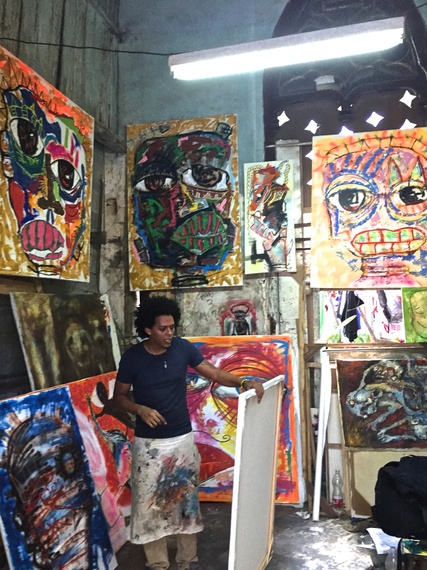
When I bought a painting from the Almost Famous Gallery, besides the authorization, the artist Dennys Santos Diaz stamped the back of the canvas with his seal. At the airport, there is a special desk where you must show the documentation before you can board your plane. When you enter the United States, you may be asked to show the authorization and a bill of sale.

When I bought a painting from the Almost Famous Gallery, besides the authorization, the artist Dennys Santos Diaz stamped the back of the canvas with his seal. At the airport, there is a special desk where you must show the documentation before you can board your plane. When you enter the United States, you may be asked to show the authorization and a bill of sale.
8. Air travel to Cuba
Some airlines fly directly to Havana from selected cities We live in Los Angeles and there are no direct flights. I preferred to use a U.S. carrier. When we flew, we took American Airlines on its flight from Havana to Miami on our way home. The plane was brand new!
9. Is it safe to drink the water?
No. Because the water has a high bacterial count, do not drink, brush your teeth or clean your contacts with the water. In the hotels, bottled water can be expensive. Buy bottled water at a local market (a Super Mercado) or ask a local where they buy theirs.
10. Walking and Talking
Always look down when you are walking to avoid tripping on broken sidewalks or under repair cobblestone streets.
Generally speaking, Havana feels safe. Crime appears to be very limited, although caution should be exercised. There is no need to flaunt your valuables by wearing expensive jewelry and watches when walking around the city. As in many Latin American countries, women on the street are sometimes the objects of unwanted attention. Mostly that means men whistling and shouting endearments. The best response is to avoid eye contact and continue enjoying your walk around the city.
When you return, please let me know about your trip. Please email me when you return. I would love to see your photographs. I posted mine from the most recent trip on Instagram: mr.manmade

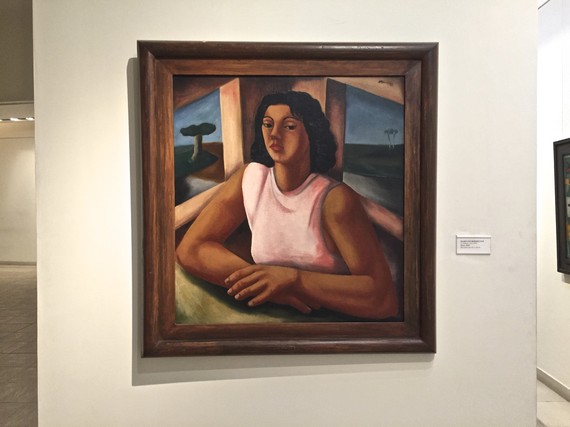

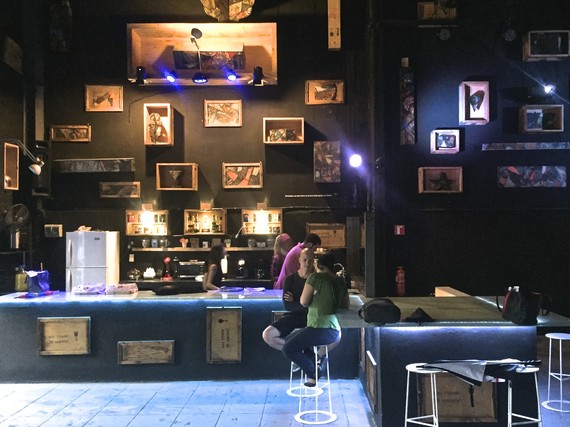
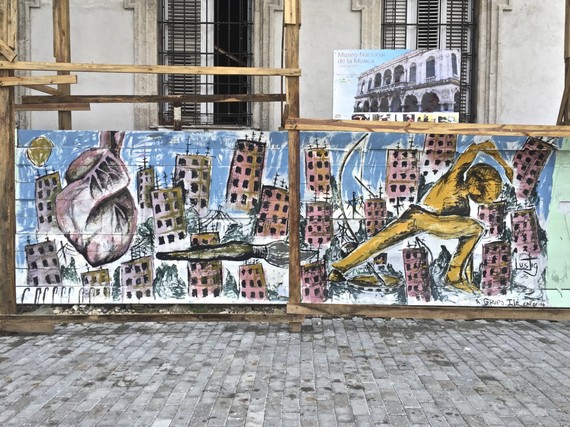
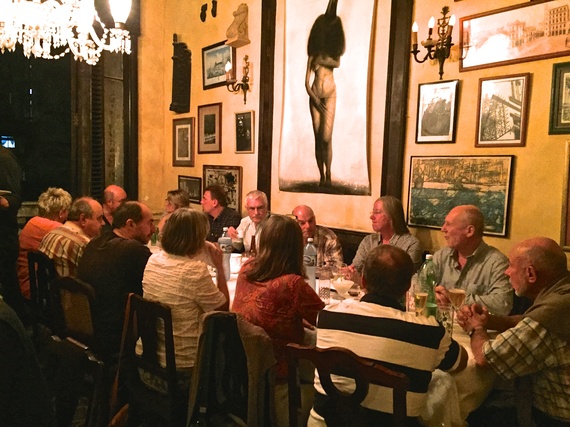
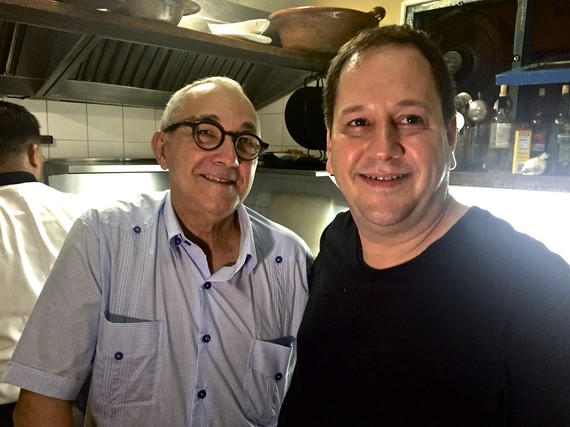
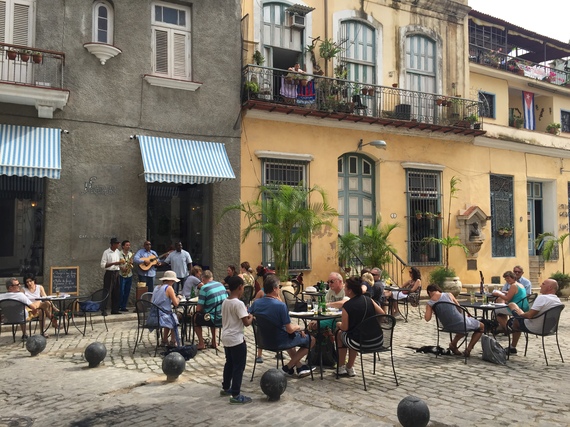
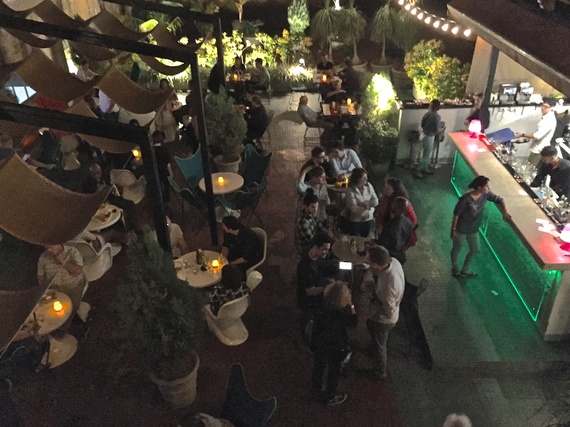
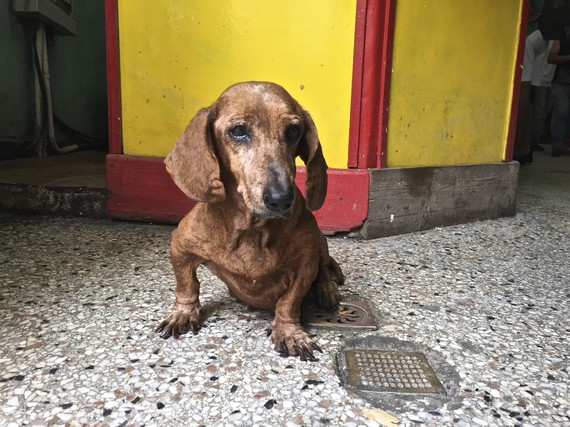
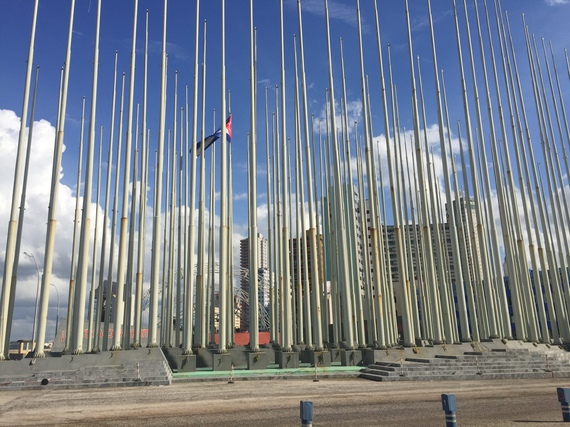
Comments